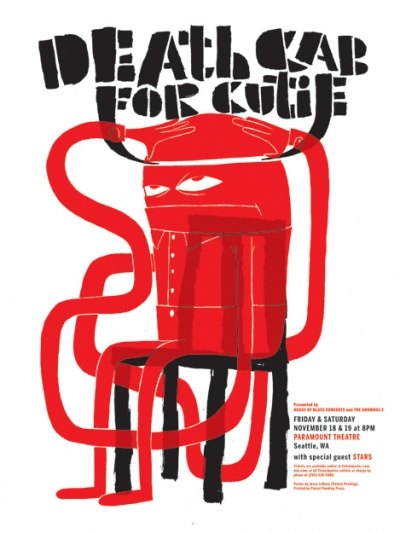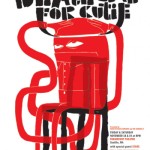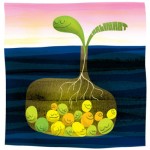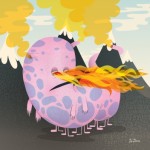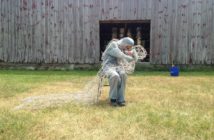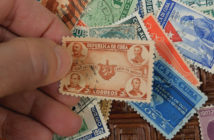By JENNIFER SCHMIDT
Jesse LeDoux has been working over seven years as an art director and designer for Seattle-based Sub Pop Records and founding member of Patent Pending Design, LeDoux created iconic album and poster artwork for such artists such as The Shins, Iron and Wine, and Hot Hot Heat before launching his own illustration/design firm LeDouxville, in 2004. With work in the permanent collection at the Experience Music Project in Seattle, his art has been exhibited nationwide and abroad. A Grammy Awards nominee, LeDoux currently works out of his studio in Tokyo, Japan, where he continues to combine his avant-garde design sensibility with the basics, "pens, pencils and a few sheets of paper."
Jennifer: As an artist and designer working in multi-media, you use a range of materials, processes and forms to express your creative sensibility and ideas.
Can you trace your creativity to when you were a kid... playing with "pens, pencils and a few sheets of paper"?
Jesse: I think that when asked, "When did you start drawing?" it's pretty common for most artists working in a visual medium to point to their childhood as where that interest began. I know cliche answers don't make for a very exciting interview, but for better or worse, I'm no exception. My birthday and Christmas wish-lists were filled with art supplies. And I was just as (if not more) content sitting by myself drawing, as I was riding bikes with the neighbor kids. Needless to say, I am the life of a party!
Jennifer: Yeah, I'm really struck with how you move so fluidly across media. Whether it be posters, t-shirts, animation, or product design. It's really great how your creative process is in many ways all inclusive, and you can throw yourself into a range of projects at any given time-- developing worlds of playful characters. Do the characters and scenes depicted in your illustrations spring out of an on-going narrative and view of the world that has its roots in your "early personal party"?
Jesse: I tend to gravitate toward things with escapist qualities. Although reality may be stranger than fiction, thoughts of the impossible are far more entertaining than those of taxes and retirement plans. By working on an array of different projects, I'm allowed to explore the alternate reality I have in my head. My work is certainly character based, but I try to not overuse any specific characters too much. Although there are common characters who pop up from time to time, I'm more interested in exploring and mapping that environment than forcing any narrative on it all. I'd rather the narrative create itself when the time is right.
Jennifer: I'm interested in the "escapist quality" you're describing, especially related to notions of the "impossible". What would be an amazing impossibility?
Jesse: Well, I certainly attest that anything I do could be considered "amazing," but I do find the open-ended possibilities that exist in the impossible appealing. The thought of a blue bear bouncing along on a pogo stick or sharing a seat on the bus with a pink octopus makes me smile.
Jennifer: Is the impossible about a "potential" - interaction and event, or is it more of a feeling? Perhaps it's both. Like stumbling upon a handwritten note and finding yourself engaged in someone else's moment of questionable certainty.
Jesse: I love the idea of creating an environment in which people would want to climb inside and get lost in for a while. I suppose it's similar to an author or director inviting you to lose yourself in a good book or movie. However, a book or movie typically forces the viewers to experience interactions and emotions, whereas I would rather the viewer imagine their own stories and add their own meaning to what they're seeing. Although I have my own ideas of what my work means to me, I prefer to keep it ambiguous enough that it can mean something completely different to somebody else. I begin to lose interest when things get too literal or logical.
Jennifer: Do you find that you draw from a collection of source material and images?
Jesse: Source material is far more of a crutch than an aid to me. I find myself trying to draw too similarly to the source image when using source material. I'm far happier with the results when I take a step back, clear my head, and allow the drawing to just happen. The mindset I get in is hard to articulate, but it feels almost as if the drawing draws itself.
Jennifer: How does your process change or adapt with each project?
Jesse: A lot of my process depends on the end result of the piece. If I'm doing a screenprint, I'll be most concerned with how colors will overprint. For gallery show work, I'll be more concerned with the details in each piece and how the images will look together on the gallery wall. For a bike helmet, I must keep in mind how the artwork will warp slightly when wrapped around the shape of the helmet. Every project has its own constraints. Harnessing those constraints is what can really make a piece come to life.
Jennifer: You've designed album covers for the Shins, Limbeck, Pedro the Lion and others, as well as gig posters for various shows. How did you first become involved with the arts and music scene?
Jesse: I first became interested in music in late junior high - growing up out in the boonies of Washington, just across the Columbia River from Portland, OR. My high school years were spent trying to go to as many rock shows as possible, and listening to as many records as I could get my hands on. I got a job working at Up Records in college, where I designed and maintained their website. Not only was I able to meet a lot of the bands on Up at the time, but Sub Pop's offices were in the same building, so I ended up becoming friends with all of those folks as well, which led to my job at Sub Pop.
Jennifer: What were some of your fave bands, movies, and books back then?
Jesse: I was really into a lot of bands from the Northwest while in high school. Unwound, Crackerbash, Hazel, Pond, the Spinanes, the Feelings, and, of course, all the Seattle heavyweights.
As for movies, all of the Disney classics were high on my list. The Goonies, Back to the Future, the Jerk, the Star Wars movies, and Pee-Wee Herman's movies and TV shows were great too.
As a kid, I remember reading and rereading books by Richard Scarry, Dr. Seuss, and all the Little Golden Books. In high school, I picked up Animal Farm because of the cover and it's relative short length but I ended up really really enjoying it.
Jennifer: I can definitely see a connection between Richard Scarry, Dr. Seuss and the way your work visually unfolds.
The books are each different in "tale" and yet, the rendering of characters, objects, and landscapes is telling of the illustrator's on-going aesthetic. For me, the worlds created in each book would spill over into the next, along with the fun and serious qualities of each story. There is a rhythm to the way the stories are written - using poetic language to poke at decision and indecision.
Looking at your work, I have a similar experience, as if bouncing from one scene to the next, questioning where I just came from.
Which brings us to the present...
Jennifer: At the moment, you're living in Tokyo. What's that like?
Jesse: It's great! Everything is an adventure. Even a walk down a boring street is really exciting. Not to mention the grocery store! It's really nice to be able to explore a city with the depth that you could never get from a short vacation. The most difficult thing (besides the language barrier, of course) is juggling my various current projects while making sure I take the necessary time to get out and explore. There is far too much to see. The fact that Japan is culturally very different from the U.S. only exaggerates it. One difference I love the most is how large of a role cartoon characters play. Even the police have a cartoon character mascot. I love it!
Jennifer: Sounds awesome. How are cartoon characters experienced there in the everyday?
Jesse: Japan really embraces cuteness. As I mentioned before, the police have a cartoon mascot. Hello Kitty was used for a major poster campaign for Tokyo's fire department. And you can't walk 3 blocks in any direction without seeing Anpanman (a Japanese cartoon hero who saves starving creatures by letting them eat his headÑwhich is made of bread filled with red bean jam) on boxes of cookies, window displays, the sides of buses, or sculptures. I even sat next to a businessman in a suit on the subway yesterday whose cellphone had a stuffed plush toy hanging from it. It's pretty funny.
Jennifer: What projects are you currently working on?
Jesse: I have two big projects on my plate right now. The first is an installation I'll be doing in the University of Maryland's art gallery. They've given me their back gallery to do as I please (which I plan to fill up with 3 walls of laughing mountains and a room of candy coated trees). I'm super excited about it. Accompanying the installation will be an edition of large diptych screen prints as well as a print for Tiny Showcase.
The second project I'm in the middle of is a series of posters for Target's Target House at St. Jude Children's Research Hospital. Target throws a big celebration for the kids four times a year, and they asked me to do the posters for this year's carnivals. I have one down, and am in the middle of the second one. I'm incredibly flattered to have been asked to do them. They've been a lot of fun.
Besides those, I always seem to have a half-dozen smaller projects to keep me plenty busy... a tote bag, a couple T-shirts, a new toy or two, and some spreads in a few books small-run art books. I'd sure like to slip a vacation in there too, though I'm not sure if that'll happen.
Jennifer: Can we hope to see some of them soon?
Jesse: You'd probably be able to see them sooner if I could ever find the time to update my website. I'll try though!
- Three examples of work by Jesse LeDoux
Jesse LeDoux will be speaking at the Art Institute of Boston on February 13, 2008.
All images are courtesy of the artist.

